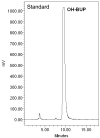Role of transporter-mediated efflux in the placental biodisposition of bupropion and its metabolite, OH-bupropion
- PMID: 20599802
- PMCID: PMC2940852
- DOI: 10.1016/j.bcp.2010.06.025
Role of transporter-mediated efflux in the placental biodisposition of bupropion and its metabolite, OH-bupropion
Abstract
Cigarette smoking during pregnancy is a preventable risk factor associated with maternal and fetal complications. Bupropion is an antidepressant used successfully for smoking cessation in non-pregnant patients. Our goal is to determine whether it could benefit the pregnant patient seeking smoking cessation. The aim of this investigation was to determine the role of human placenta in the disposition of bupropion and its major hepatic metabolite, OH-bupropion. The expression of efflux transporters P-gp and BCRP was determined in placental brush border membrane (n=200) and revealed a positive correlation (p<0.05). Bupropion was transported by BCRP (K(t) 3 microM, V(max) 30 pmol/mg protein/min) and P-gp (K(t) 0.5 microM, V(max) 6 pmol/mg protein min) in placental inside-out vesicles (IOVs). OH-bupropion crossed the dually-perfused human placental lobule without undergoing further metabolism, nor was it an efflux substrate of P-gp or BCRP. In conclusion, our data indicate that human placenta actively regulates the disposition of bupropion (via metabolism, active transport), but not its major hepatic metabolite, OH-bupropion.
Copyright (c) 2010 Elsevier Inc. All rights reserved.
Figures











Similar articles
-
Formation and efflux of ATP-binding cassette transporter substrate 2,4-dinitrophenyl-S-glutathione from cultured human term placental villous tissue fragments.Mol Pharm. 2009 Nov-Dec;6(6):1689-702. doi: 10.1021/mp900019z. Mol Pharm. 2009. PMID: 19397308
-
Opiates inhibit paclitaxel uptake by P-glycoprotein in preparations of human placental inside-out vesicles.Biochem Pharmacol. 2009 Nov 1;78(9):1272-8. doi: 10.1016/j.bcp.2009.07.002. Epub 2009 Jul 8. Biochem Pharmacol. 2009. PMID: 19591810 Free PMC article.
-
Sertraline and its metabolite desmethylsertraline, but not bupropion or its three major metabolites, have high affinity for P-glycoprotein.Biol Pharm Bull. 2008 Feb;31(2):231-4. doi: 10.1248/bpb.31.231. Biol Pharm Bull. 2008. PMID: 18239278 Free PMC article.
-
An update on expression and function of P-gp/ABCB1 and BCRP/ABCG2 in the placenta and fetus.Expert Opin Drug Metab Toxicol. 2018 Aug;14(8):817-829. doi: 10.1080/17425255.2018.1499726. Epub 2018 Aug 3. Expert Opin Drug Metab Toxicol. 2018. PMID: 30010462 Free PMC article. Review.
-
Efflux transporters of the human placenta.Adv Drug Deliv Rev. 2003 Jan 21;55(1):125-32. doi: 10.1016/s0169-409x(02)00174-6. Adv Drug Deliv Rev. 2003. PMID: 12535577 Review.
Cited by
-
Metabolism and disposition of bupropion in pregnant baboons (Papio cynocephalus).Drug Metab Dispos. 2014 Oct;42(10):1773-9. doi: 10.1124/dmd.114.058255. Epub 2014 Aug 5. Drug Metab Dispos. 2014. PMID: 25097227 Free PMC article.
-
Enhanced brain disposition and effects of Δ9-tetrahydrocannabinol in P-glycoprotein and breast cancer resistance protein knockout mice.PLoS One. 2012;7(4):e35937. doi: 10.1371/journal.pone.0035937. Epub 2012 Apr 20. PLoS One. 2012. PMID: 22536451 Free PMC article.
-
Basal Ti level in the human placenta and meconium and evidence of a materno-foetal transfer of food-grade TiO2 nanoparticles in an ex vivo placental perfusion model.Part Fibre Toxicol. 2020 Oct 7;17(1):51. doi: 10.1186/s12989-020-00381-z. Part Fibre Toxicol. 2020. PMID: 33023621 Free PMC article.
-
Pharmacotherapy for mood disorders in pregnancy: a review of pharmacokinetic changes and clinical recommendations for therapeutic drug monitoring.J Clin Psychopharmacol. 2014 Apr;34(2):244-55. doi: 10.1097/JCP.0000000000000087. J Clin Psychopharmacol. 2014. PMID: 24525634 Free PMC article. Review.
-
Placental ABC Transporters: Biological Impact and Pharmaceutical Significance.Pharm Res. 2016 Dec;33(12):2847-2878. doi: 10.1007/s11095-016-2028-8. Epub 2016 Sep 19. Pharm Res. 2016. PMID: 27644937 Free PMC article. Review.
References
-
- Rogers JM. Tobacco and pregnancy. Reprod Toxicol. 2009 Sep;28(2):152–60. - PubMed
-
- England LJ, Grauman A, Qian C, Wilkins DG, Schisterman EF, Yu KF, Levine RJ. Misclassification of maternal smoking status and its effects on an epidemiologic study of pregnancy outcomes. Nicotine Tob Res. 2007 Oct;9(10):1005–13. - PubMed
-
- Lumley J, Oliver SS, Chamberlain Cl. Interventions for promoting smoking cessation during pregnancy. Cochrane Database Syst Rev. 2004:CD001055. - PubMed
-
- Slotkin TA. If nicotine is a developmental neurotoxicant in animal studies, dare we recommend nicotine replacement therapy in pregnant women and adolescents? Neurotoxicology and Teratology. 2008;30:1–19. - PubMed
-
- Pauly JR, Slotkin TA. Maternal tobacco smoking, nicotine replacement and neurobehavioural development. Acta Paediatrica. 2008;97:1331–1337. - PubMed
Publication types
MeSH terms
Substances
Grants and funding
LinkOut - more resources
Full Text Sources
Medical
Miscellaneous

